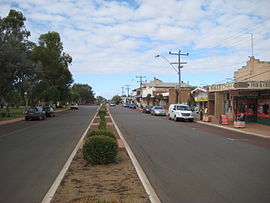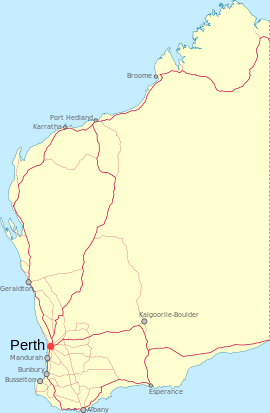- Dalwallinu, Western Australia
-
Dalwallinu
Western Australia
The main street in Dalwallinu.Population: 593 (2006 Census)[1] Established: 1914 Postcode: 6609 Elevation: 335 m (1,099 ft) Location: 248 km (154 mi) NNE of Perth LGA: Shire of Dalwallinu State District: Moore Federal Division: Durack Mean max temp Mean min temp Annual rainfall 26.0 °C
79 °F12.1 °C
54 °F357.3 mm
14.1 inCoordinates: 30°16′16″S 116°39′40″E / 30.271°S 116.661°E
Dalwallinu is a town in the Wheatbelt region of Western Australia, located 248 km from Perth via the Great Northern Highway. Agriculture and supporting industries are the town's primary economic activities. The town is also the first town on The Wildflower Way, a world-famous Western Australian tourist route which stretches north to Mullewa. The town has an elevation of 335 m.[2] At the 2006 census, Dalwallinu had a population of 593.[1]
The name of the town comes from the Aboriginal word that means "place to wait a while" or possible "goodlands". The first inhabitants of the area were nomadic and had no set boundaries and the area was mostly used for hunting and gathering. The Badima people lived in the northern areas of the shire and the Galamaia peoples inhabited the southern areas.[3]
The site of the town was originally a station on the train line between Wongan Hills and Mullewa and was later officially gazetted in 1914.[4]
The first Europeans to arrive were Benedictine monks who came from New Norcia to graze their sheep on the pastoral leases that they had taken up. The first settlers arrived, hoping to develop the lands for wheat, in 1907. The region was surveyed in 1909 and then opened for selection in 1910 with crops being planted shortly afterward.[5]
Two brothers, Albert and Frederick Ellison, built a well on the southern end of the township in 1909. The well acted as a permanent source of water to the settlers. The well, named Billum Billum well, was built from locally occurring timber such as Gimlet and Salmon Gum.[6]
References
- ^ a b Australian Bureau of Statistics (25 October 2007). "Dalwallinu (L) (Urban Centre/Locality)". 2006 Census QuickStats. http://www.censusdata.abs.gov.au/ABSNavigation/prenav/LocationSearch?collection=Census&period=2006&areacode=UCL506000&producttype=QuickStats&breadcrumb=PL&action=401. Retrieved 6 July 2011.
- ^ "Bureau of Meteorology - Dalwallinu Comparison". 2008. http://www.bom.gov.au/climate/averages/tables/cw_008039.shtml. Retrieved 2008-08-26.
- ^ "Australia's Golden Outback - Dalwallinu". 2005. http://www.australiasgoldenoutback.com/en/Wheatbelt/Towns/Dalwallinu/default.htm. Retrieved 2008-08-26.
- ^ Western Australian Land Information Authority. "History of country town names". http://www.landgate.wa.gov.au/corporate.nsf/web/History+of+country+town+names. Retrieved 2008-08-26.
- ^ "Welcome to Western Australia - Dalwallinu". 2005. http://www.westernaustralia.com/en/Pages/Destination.aspx?n=Dalwallinu&pid=9004563. Retrieved 2008-08-26.
- ^ "Billum-Billum Monks Well". 2002. http://australia.shopsafe.com.au/western_australia_attractions/central_wildflower_country_attractions/dalwallinu/billumbillum_monks_well-historical_sites_heritage_locations.htm. Retrieved 2008-08-26.
Categories:- Towns in Western Australia
- Australian Aboriginal placenames
- Western Australia geography stubs
Wikimedia Foundation. 2010.

